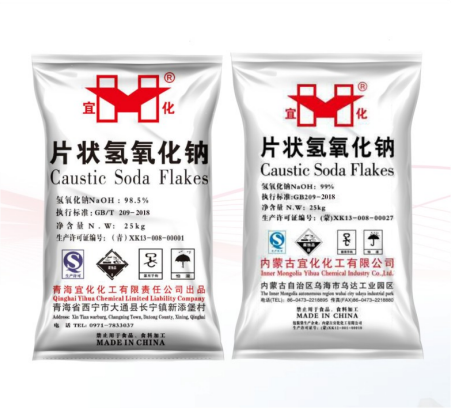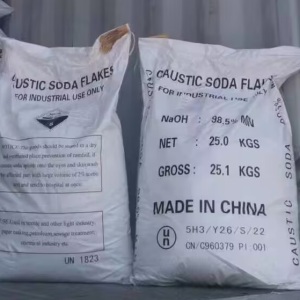
 Hubei, China
Hubei, China
 Hubei, China
Hubei, China
Send Email





Caustic Soda Flakes / CAS 1310-73-2
OVERVIEW
Benefits
SHUANGHUAN TECHNOLOGY is one of the world's largest Hydrazine production enterprises, with a large annual production capacity.
Yihua has built more than 40 R&D centers and production bases in the country, with a mature and perfect marketing network system, leading products sell well in many countries at home and abroad, and enjoy a good reputation in the market.
Tablet alkali is pure production, not by-product, excellent quality.
Specification
Commodity Name: Caustic Soda Flakes CAS NO.: 1310-73-2 | ||||
Standard No.: GB 209-2006 | NaOH % | Na2CO3 % | NaCl % | Fe2O3 % |
98.5 MIN | 0.5 MAX | 0.03 MAX | 0.005 MAX | |
RESULT | 98.7 | 0.3 | 0.02 | 0.002 |
Uses
Industrial grade caustic soda is used in papermaking and cellulose pulp production.
Caustic soda is used in the production of soaps, synthetic detergents, synthetic fatty acids and the refining of animal and vegetable oils and fats.
Caustic soda is used as cotton desizing agent, scouring agent and mercerizing agent in the textile printing and dyeing industry.
Soda ash is used in the chemical industry to produce borax, sodium cyanide, formic acid, oxalic acid, phenol, etc.
Soda ash is used in the petroleum industry to refine petroleum products and is used in oilfield drilling mud.
Caustic soda is also used in the surface treatment of aluminum oxide, metallic zinc and metallic copper, as well as in glass, porcelain, tanning, medicine, dyes, and pesticides.
- P-Cresol P-Cresol
- Sodium Gluconate Sodium Gluconate
- Cationic Starch Cationic Starch
- Sodium Methoxide Sodium Methoxide
- Glycine Betaine Glycine Betaine
- Tetrabutylurea Tetrabutylurea
- 1H-Imidazole, 2-(2-Chlorophenyl)-1-[2-(2-Chlorophenyl)-4,5-Diphenyl-2H- 1H-Imidazole, 2-(2-Chlorophenyl)-1-[2-(2-Chlorophenyl)-4,5-Diphenyl-2H-
- Sodium Chlorite Sodium Chlorite
- 4-Methylmorpholine 4-Methylmorpholine
- N-Methylmorpholine N-Oxide N-Methylmorpholine N-Oxide
- 1,4-Dioxane 1,4-Dioxane
- 4,4'-(1-Phenylethylidene) Biphenol 4,4'-(1-Phenylethylidene) Biphenol
- N-Hydroxyphthalimide N-Hydroxyphthalimide
- Sodium Propionate Sodium Propionate
- Sodium Acetate Sodium Acetate
- Sodium Dehydroacetate Sodium Dehydroacetate
- Sodium Benzoate Sodium Benzoate
- 2-Amino-5-Nitrophenol 2-Amino-5-Nitrophenol
- 3-Aminophenylacetylene 3-Aminophenylacetylene
- 4-Methoxybenzoic Acid 4-Methoxybenzoic Acid
- Sodium Pyroantimonate Sodium Pyroantimonate
- Sodium Formate Sodium Formate
- Atrazine Atrazine
- Sulfachloropyrazine Sodium Sulfachloropyrazine Sodium
- Sulfachlorpyridazine Sodium Sulfachlorpyridazine Sodium
- Sulfadimethoxine Sodium Salt Sulfadimethoxine Sodium Salt
- Sulfacetamide Sodium Sulfacetamide Sodium
- Benfotiamine Benfotiamine
- Clopidol Clopidol
- 3,5,6-Trichloropyridin-2-Ol Sodium 3,5,6-Trichloropyridin-2-Ol Sodium
- Hydroxypropyl Methyl Cellulose Hydroxypropyl Methyl Cellulose
- Phenoxyacetic acid Phenoxyacetic acid
- Sodium Lactate Sodium Lactate
- Crotonaldehyde Crotonaldehyde
- Disodium Phosphonomycin Disodium Phosphonomycin
- 2-Chloro-2-Ethoxyacetic acid Ethyl Ester 2-Chloro-2-Ethoxyacetic acid Ethyl Ester
- Bronopol Bronopol
- 2,2-Dibromo-2-Nitro Ethanol 2,2-Dibromo-2-Nitro Ethanol
- Sodium Bromide Sodium Bromide
- Sodium Bromate Sodium Bromate
- Trichlorocyanuric Acid Trichlorocyanuric Acid
- Simvastatin Simvastatin
- Levofloxacin Hemihydrate Levofloxacin Hemihydrate
- Mycophenolic Acid Mycophenolic Acid
- Dimercaptosuccinic Acid Dimercaptosuccinic Acid
- Repaglinide Repaglinide
- Molasses Molasses
- Erbium Oxide Erbium Oxide
- Sodium Oxalate Sodium Oxalate
- Hydroxypropyl Starch Hydroxypropyl Starch
- Starch Acetate Starch Acetate
- Sodium Carboxymethyl Cellulose Sodium Carboxymethyl Cellulose
- Sodium Carboxyl Methylstarch Sodium Carboxyl Methylstarch
- Levetiracetam Levetiracetam
- Triazamate Triazamate
- Sodium Dithionite Sodium Dithionite
- Pentaerythritol Pentaerythritol
- Eddha-Fena Eddha-Fena
- Salicylaldehyde Salicylaldehyde
- Copper Quinolate Copper Quinolate
- Jasmone Jasmone
- Calcium Stearate Calcium Stearate
- Magnesium Stearate Magnesium Stearate
- Sodium Stearate Sodium Stearate
- Lauric Acid Sodium Salt Lauric Acid Sodium Salt
- Lauric Acid Sodium Salt Lauric Acid Sodium Salt
- Octamethylcyclotetrasiloxane Octamethylcyclotetrasiloxane
- Trisodium Phosphate Trisodium Phosphate
- Trisodium Phosphate Trisodium Phosphate
- Trisodium Citrate Dihydrate Trisodium Citrate Dihydrate
- Cuprous Oxide Cuprous Oxide
- Ethylenediaminetetraacetic Acid Ethylenediaminetetraacetic Acid
- Glycine Glycine
- Iminodiacetic Acid Iminodiacetic Acid
- Direct Red 23 Direct Red 23
- Direct Red 227 Direct Red 227
- Cobalt Naphthenate Cobalt Naphthenate
- Phenylhydrazine Phenylhydrazine
- Chlorpyrifos Chlorpyrifos
- Hydroxyethyl Starch Hydroxyethyl Starch
- Zinc Thiazole Zinc Thiazole
- 1,3-Cyclohexanedione 1,3-Cyclohexanedione
- Nicotinamide Nicotinamide
- Hydroxypropyl Cellulose Hydroxypropyl Cellulose
- 2-Hydroxypropyl-β-Cyclodextrin 2-Hydroxypropyl-β-Cyclodextrin
- Captisol Captisol
- 1-Naphthol-4-Sulfonic Acid 1-Naphthol-4-Sulfonic Acid
- 1-Naphthol 1-Naphthol
- 1-Naphthol 1-Naphthol
- Sodium Molybdate Sodium Molybdate
- Sodium Metasilicate Sodium Metasilicate
- 2,3-Dichloroanisole 2,3-Dichloroanisole
- Sodium 2-Ethylhexanoate Sodium 2-Ethylhexanoate
- Ethyl 2-Methylbutyrate Ethyl 2-Methylbutyrate
- Nonyl Phenoxypolyethoxylethanol Nonyl Phenoxypolyethoxylethanol
- Zinc Hydroxide Zinc Hydroxide
- Pitavastatin Calcium Pitavastatin Calcium
- Bisphenol-A Epoxy Resin Bisphenol-A Epoxy Resin
- (E)-Dimethomorph (E)-Dimethomorph
- 2-Chloro-5-Chloromethylpyridine 2-Chloro-5-Chloromethylpyridine
- Bentazone Bentazone
- Cationic Polyacrylamide Cationic Polyacrylamide
- Sodium Lauroylsarcosinate Sodium Lauroylsarcosinate
- 4-[[4-(2-Propenyloxy)Phenyl]Sulfonyl]Phenol 4-[[4-(2-Propenyloxy)Phenyl]Sulfonyl]Phenol
- 1-Prop-2-Enoxy-4-(4-Prop-2-Enoxyphenyl)Sulfonylbenzene 1-Prop-2-Enoxy-4-(4-Prop-2-Enoxyphenyl)Sulfonylbenzene
- 2-Nitrophenyl-Beta-D-Galactopyranoside 2-Nitrophenyl-Beta-D-Galactopyranoside
- 4-Nitrophenyl-Beta-D-Galactopyranoside 4-Nitrophenyl-Beta-D-Galactopyranoside
- X-Gluc X-Gluc
- X-gal X-gal
- Benzoyl Peroxide Benzoyl Peroxide
- Carbon Dioxide Absorbent Carbon Dioxide Absorbent
- Sodium Hypophosphite Monohydrate Sodium Hypophosphite Monohydrate
- Barium Hydroxide Octahydrate Barium Hydroxide Octahydrate
- Loratadine Loratadine
- Cilostazol Cilostazol
- Adapalene Adapalene
- 2R Acid 2R Acid
- Sodium Butyrate Sodium Butyrate
- Sodium Gluconate Sodium Gluconate
- Sodium Naphthalene Sulfonate Formaldehyde Sodium Naphthalene Sulfonate Formaldehyde
- Sodium Salt Of Polynaphthalene Sulphonic Acid Sodium Salt Of Polynaphthalene Sulphonic Acid
- Salicylic Acid Salicylic Acid
- Sodium,(2S)-2-(Dodecanoylamino)-5-Hydroxy-5-Oxopentanoate Sodium,(2S)-2-(Dodecanoylamino)-5-Hydroxy-5-Oxopentanoate
- Sodium Lauroyl Methyl Taurate Sodium Lauroyl Methyl Taurate
- O-Anisidine O-Anisidine
- O-Phenetidine O-Phenetidine
- P-Anisidine P-Anisidine
- 4-Ethoxyaniline 4-Ethoxyaniline
- Tolytriazole Sodium Salt Tolytriazole Sodium Salt
- Iron Oxide Red Iron Oxide Red
- Iron Oxide Black Iron Oxide Black
- Iron Oxide Yellow Iron Oxide Yellow
- Sodium Hypochlorite Sodium Hypochlorite
- Silicon Oxide Silicon Oxide
- Sodium Polyacrylate Sodium Polyacrylate
- Polyoxirane-2,3-Dicarboxylic Acid Polyoxirane-2,3-Dicarboxylic Acid
- Poly-L-Aspartic Acid Poly-L-Aspartic Acid
- Ethylene Diamine Tetra(Methylene Phosphonic Acid)Sodium Ethylene Diamine Tetra(Methylene Phosphonic Acid)Sodium
- Diethylenetriamine Penta(Methylene Phosphonic Acid) Heptasaodium Salt Diethylenetriamine Penta(Methylene Phosphonic Acid) Heptasaodium Salt
- Diethylenetriamine Penta(Methylene Phosphonic Acid) Heptasaodium Salt Diethylenetriamine Penta(Methylene Phosphonic Acid) Heptasaodium Salt
- O-Methoxybenzaldehyde O-Methoxybenzaldehyde
- 3,5-Dihydroxybenzoic Acid 3,5-Dihydroxybenzoic Acid
- 3,5-Dihydroxybenzoic Acid 3,5-Dihydroxybenzoic Acid
- 3-Indoleformic Acid 3-Indoleformic Acid
- Copper Formate Copper Formate
- Ferric Oxide Ferric Oxide
- Sodium Cocoyl Glycinate Sodium Cocoyl Glycinate
- Cocoamidopropyl Betaine Cocoamidopropyl Betaine
- Sodium Perborate Monohydrate Sodium Perborate Monohydrate
Packaging
25 KG/Woven Bag
Lead Time
14-30 days
Max Capacity
60000 MT/Year
REQUEST A QUOTATION
SubmitDESCRIPTION
Product Name
Caustic Soda Flakes, solid alkali, sodium hydroxide
Material Properties
Chemical name: Caustic Soda
Molecular formula: NaOH Molecular weight: 40
Melting point: 318.4℃ Boiling point: 1390℃
CSA number: 130-73-2
Chemical Properties:
Solid caustic soda is soluble in ethanol and glycerin; insoluble in acetone and ether. It is extremely corrosive and corrosive to fibers, skin, glass, ceramics, etc. It reacts with metallic aluminum and zinc, non-metallic boron and silicon to release hydrogen; it reacts with chlorine, bromine, iodine and other halogens to produce disproportionation reaction; it neutralizes with acids to generate salt and water. Pure anhydrous sodium hydroxide is a white translucent, crystalline solid. Sodium hydroxide is very soluble in water, and its solubility increases with the increase of temperature. It can release a lot of heat when dissolving. Its saturated solution concentration can reach 26.4mol/L (1:1) at 288K. Its solution has an astringent taste and a smooth feeling, and the solution is strongly alkaline and has all the properties of an alkali.
Product Usage:
Sodium hydroxide is mainly used in papermaking, cellulose pulp production, production of soap, synthetic detergents, synthetic fatty acids, and refining of animal and vegetable oils and fats. In the textile printing and dyeing industry, it is used as cotton desizing agent, scouring agent and mercerizing agent. In the chemical industry, it is used to produce ketone sand, sodium cyanide, formic acid, oxalic acid, phenol, etc. It is used in the petroleum industry to refine petroleum products and in oil field drilling mud. It is also used in the production of surface treatments for alumina, zinc metal and copper metal, as well as in glass, porcelain, tanning, medicine, dyes, and pesticides. Food-grade products are used as acid neutralizers in the food industry, as peeling agents for citrus and peaches, and as detergents for empty bottles and cans, as well as decolorizing and deodorizing agents. It is widely used in chemical industry, paper making, printing and dyeing, electric power and other industries. It is also used as an additive in the coal bonding process in fertilizer plants.
Storage:
When storing solid sodium hydroxide, pay attention to sealing it tightly to prevent it from being exposed to the air, absorbing moisture, deliquescing or mixing with carbon dioxide. When using a glass bottle to hold caustic soda or other forms of sodium hydroxide, do not use a glass bottle stopper. Instead, use a rubber stopper. This is because sodium hydroxide will react with the silica in the glass to form sodium silicate, causing the bottle stopper to become damaged. The bottle body is bonded and difficult to open.
Typical Properties
Agrochemicals > Pesticide Adjuvants
GET SAMPLE
Submit- Overview
- Documents
- Descriptions
- Sample




































